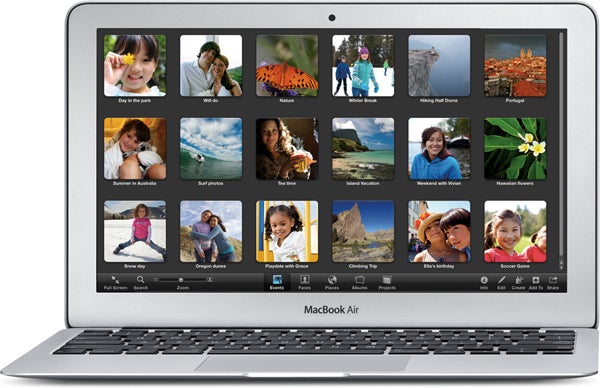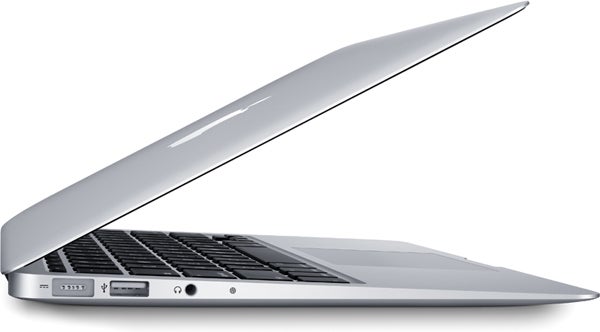MacBook Air 11in (Late 2010) Review
MacBook Air 11in (Late 2010)
Beautifully designed, stylish, portable... just don't call it a netbook.

Verdict
Pros
- Excellent battery life
- Beautiful design
- Fast boot-up
Cons
- Pricey
- Small screen
- No SD card slot
Key Specifications
- Review Price: £849.00
- 1.4GHz CPU
- 1.06kg
- 2GB of RAM
- nVidia 320M graphics chip
- 64GB of flash storage
The industrial design of the 11in MacBook Air, if nothing else, confirms that this system is playing, not just in a different league to netbooks, but a different game to them entirely. Shrinking the aluminium unibody design of the 13in MacBook Air into a system measuring 300mm x 192mm x 17mm (Apple’s 3mm to 17mm height dimension is somewhat misleading, as the system is only 3mm thick at the very edge) hasn’t made it look any less fantastic, and more importantly hasn’t made it feel any less premium. At 1.06kg it’s reassuringly heavy, but still light enough to use on your lap for extended periods. Put simply: the 11in MacBook Air isn’t just a system that feels like it could survive daily use, it’s a system that you will want to use daily.
Obviously such a premium feel doesn’t come without cost, and at £849 for the entry level system the MacBook air is definitely costly. That money buys you a 1.4GHz CPU, 2GB of RAM, 64GB of flash storage and an nVidia 320M graphics chip. £999 will get you that same spec, but with 128GB of storage. The flash storage aside, which is a great addition, the components are nothing spectacular, but are definitely acceptable – you certainly don’t need anything faster or more powerful for a portable machine. 
As with the MacBook Air 13in, the memory is hardwired in, so if you suspect you’ll want 4GB, be prepared to stump up a further £80. The criminally wealthy or insane can opt for a 1.6GHz processor, likewise for £80, as long as they want to add it to the already expensive 128GB system. Far be it for us to dictate how you use your laptop, but we really can’t see why anyone would upgrade anything but the RAM in an 11in MacBook Air – and even that improvement isn’t likely to be needed by most users.
Because it uses the same components, it’s unsurprising to find that the 11in MacBook Air performs no differently to the 13in system. All of the tasks a MacBook Air user is likely to want to carry out ran smoothly without any issues, from watching HD trailers on YouTube, to encoding video footage, pulled from an iPhone, in iMovie. The small screen size is likely to preclude you from multitasking before the speed of the system does.
As with the 13in MacBook Air the 11in system’s flash storage means that it boots up in record time and loads programs with almost alarming haste. Battery life is also excellent, with Apple’s claim of five hours falling short of the six we were able to squeeze out of the Air with the brightness turned down half way, and nothing more taxing than Word 2011 and Safari running. We think that’s a fair representation of how the average 11in MacBook Air will use their system.![]()
Its display is another area where the 11in MacBook Air meets our expectations for a premium system of its size. The LED-backlit unit gives accurate, but vivid colour reproduction and its 1,366 x 768 pixel resolution provides plenty of desktop real estate, proving a definite improvement over those similarly sized, portable laptops that only offer a 1,280 x 600 pixel display. Lest we forget, however, Sony was pulling the same trick back in 2007 with its Vaio TZ (and was well ahead of the competition at the time), so Apple is hardly a pioneer in this area.
One aspect of the 11in MacBook Air we can unconditionally praise is its keyboard. Despite fitting into a confined area, the keys are surprisingly well sized and, like countless other MacBook keyboards before, give an excellent, crisp feedback. The only concession to the space restrictions we noticed was the shrinking of the arrow, power, escape, and F1-F12 keys, but we use those rarely enough that we never found it a problem.
To our delight, Apple’s now-ubiquitous multi-touch enabled touchpad has found its way into the 11in MacBook Air. Although noticeably smaller than the example in the 13in Air, and the rest of the MacBook range, it proves no less excellent an input device on this system. In fact, because of the lesser space in the 11in chassis, it’s possible that being able to eschew buttons was some help in finding enough space for the excellent keyboard. Regardless whether that is true or not, we’re definitely fans of the numerous multi-touch gestures available to a MacBook Air user – they really do make navigating OS X and its programs so much easier.
What the 11in MacBook Air doesn’t do so well is connectivity. We’re happy to accept that there’s no disc drive, despite laptops smaller than this offering such features five years ago (the Vaio T1XP to be precise) – it’s an omission that seems to have become standard in this class of laptops. What we aren’t so pleased with is the inexplicable lack of an SD card slot on the 11in Air; there’s space for it, and it would clearly be useful, so we really don’t understand why it’s missing from the smaller of the Airs.
Once again we have to also lament Apple’s use of a mini-DisplayPort video output. On Apple’s more powerful systems, a DisplayPort port is indeed useful, as it enables connection to a high-resolution display, but on a laptop of this size being able to easily connect to a TV would be much more useful. Last, but not least, the presence of only two USB ports is disappointing. Again, we appreciate that space is at a premium on such a small system, but more ports would fit if Apple gave the Air a slightly more rectangular cross-section, which wouldn’t actually make it thicker in any meaningful way.
To take an example: the Acer Aspire Timeline 1810TZ, our Best Portable Laptop award-winner in 2009, has the same resolution display, is hardly less portable (20mm-30mm thick to be specific), and offers an SD card reader, an HDMI-output, and three USB ports, giving it more connectivity that the 11in MacBook Air for some £400 less money. And that’s ignoring the eight and a half hour battery life – almost half again what the Air manages.
It’s a similar case with the Dell Inspiron M101z; again the specs match or best the Air, for a lot less money and the build quality for the most part is impeccable, if not quite to the level of the Air. The M101z even looks pretty sharp, although unlike the 1810TZ the Inspiron doesn’t have MacBook Air-beating battery life, but it is the handsomer and sturdier of the two systems.
Even accounting for the inarguably superior build quality and aesthetics of the unibody chassis, and the use of super-fast flash memory in the 11in MacBook Air, it’s hard to see quite how Apple intends to justify the massive premium it carries over rival 11in laptops. One almost expects that a not insubstantial chunk of that money is there intentionally to dissuade those who want a cheap cheerful netbook; a metaphorical middle finger directed by Steve Jobs toward those who can’t or won’t buy a ‘real’ laptop.
Verdict
As much as the MacBook Air is a beautiful machine, you really do have to think carefully before buying one. There are myriad alternative laptops that are no less portable, and that almost universally offer better specs than the 11in Air. If, therefore, you’re the kind of person that cares purely about what you physically get for your money, this isn’t the system for you.
However, if you think value is in more than just the price, have the money to burn, and want an ultra-portable laptop that, as well as being capable of performing all he every day tasks you throw at it, makes you feel satisfied just to have used it, then you should definitely consider an 11in MacBook Air.
How we test laptops
Unlike other sites, we test every laptop we review thoroughly over an extended period of time. We use industry standard tests to compare features properly. We’ll always tell you what we find. We never, ever, accept money to review a product.
Trusted Score
Score in detail
-
Performance 7
-
Design 10
-
Value 6
-
Features 6
Processor, Memory & Storage
| Processor | Intel Core 2 Duo |
| Processor Speed Standard (Gigahertz) | 1.40 GHz |
| Memory (RAM) (Gigabyte) | 2 GB |
| Hard Disk Drive (HDD) (Gigabyte) | Not IncludedGB |
Graphics & Sound
| Graphics | nVIDIA GeForce 320M |
| Display (Inch) | 11.6 in |

